How to flush a gas bottle: safe ways to flush the receiver
Have you ever encountered the problem of cleaning an old gas bottle? Sometimes even the classical method of bleeding propane is not enough for further safe operation with the tank. Residues of gas can accumulate inside the cylinder, which, during metal sawing, can cause a fire or explosion.
Agree, it is better to be safe to avoid an emergency. There are several ways to flush a gas cylinder using different solutions that eliminate propane residues.
When working with a gas receiver, an important condition is the creation of a safe environment, which in this case is ensured by cleaning the tank from gas. We have chosen some of the safest ways to flush a gas cylinder, allowing us to get rid of not only gas residues, but also the acrid smell of propane.
The content of the article:
Preparing the bottle for cleaning
A huge number of instructions for the manufacture of various designs from a propane receiver can confuse even a professional craftsman. Now everyone can build barbecue, a smokehouse and even potbelly stove, however, not everyone knows the rules for preparing a gas cylinder for further use.
For many years, gas residues can be stored inside the cylinder, which, when interacting with the slightest spark, can lead to an explosion. Therefore, the first thing you need to do is try to unscrew it yourself valve for bleeding gas, using a conventional gas key.

It will not be difficult to untwist a serviceable valve, however, if it is damaged, problems can arise, and it is unlikely to unscrew it with a key. In this case, you will have to resort to removing the valve by cutting with a hacksaw, however, during the sawing of the valve, the likelihood of a spark increases, which can trigger an explosion.
If the valve is successfully untwisted, a small hole can be seen in its place, through which it is possible to flush the gas cylinder. Often, ordinary water is used to clean the container, which allows you to quickly and safely remove residual propane, but this will not completely eliminate the pungent odor of gas.
Therefore, in this case, it is recommended to use solutions with the addition of substances necessary for more effective cleaning of the receiver.
Read more about how to disassemble a gas cylinder Further.
Flushing a gas bottle with water
When the valve is unscrewed, it is found that the diameter of the washing hole is only 6 mm, which means filling a 50 liter gas cylinder with the same volume of liquid will be somewhat problematic.
A quick option is to lower the receiver into a bath of water, but in this case you should prepare for the fact that the whole room smells of the pungent odor of propane, which will be quite difficult to get rid of.

It is better to carry out flushing work far from residential premises, while filling gas bottle liquid can be in other ways. To do this, you need to prepare a thin 5 mm hose and an ordinary 6 liter plastic bottle, which from time to time will have to be filled with water.
The gas tank is filled with water as follows:
- a water bottle is placed on a hill (car hood, for example), a balloon is installed nearby;
- it is necessary to extend the hose between the container and the receiver, and the water will gradually overflow from one container to another;
- to speed up the process, you can install a vessel with water at a high height, but in this case you will have to find a longer hose.
With maximum filling of the tank, water displaces the gas, washing away even the smallest residues of propane. For the best effect, it is recommended to leave the cylinder filled with water for about a day, and only after that proceed to the next stage - draining the liquid.
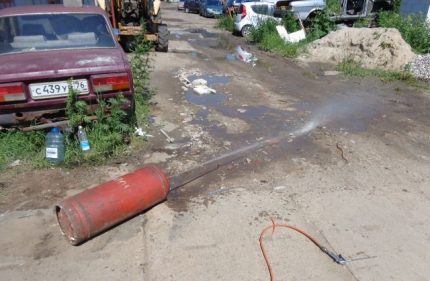
If filling a balloon takes quite a while, then draining the water may seem like an eternity. The compressor will help to speed up the process, to which a thin hose is connected with a purge gun at the end. With the help of such a simple device, compressed air will be injected into the cylinder.
In this case, it is enough to pump air a little, after which you will need to quickly remove the gun along with the hose. It is not recommended to remove the gun first, and then the hose, since there is a chance of falling under a cold “gas” shower. As necessary, the air inside the cylinder can be replenished, which will remove all the liquid from the cylinder in the shortest possible time.
Other safe ways to flush the receiver
To detect leaks, a special flavor is intentionally added to natural gas - an odorant with a pungent odor, which we are used to perceiving as a gas odor. Even after you clean the propane gas bottle with plain water, the smell may not go away.
Since the washing process of the receiver is quite long, it is better to immediately prepare a suitable solution with the addition of substances that neutralize any odors.

The most commonly used odorant is mercaptan - a persistent and pungent flavoring, in large quantities harmful to human health.
If you do not know how to rinse the old gas cylinder from the smell of mercaptan, you can use the following solutions:
- Vinegar. The product is known for its amazing neutralization properties of absolutely any odors, while the aroma of vinegar itself disappears in the shortest possible time. To flush the gas receiver, you will need to dilute a small amount of 70% acetic acid in 50 liters of water. In this case, it is impossible to overdo it, especially for such a large amount of water.
- Potassium permanganate. The substance not only helps eliminate the pungent odor of gas, but also removes gasoline residues. Do not worry about the color of the solution, this will not affect the quality of the metal. In the process of preparing the solution, it is important to achieve a pale pink color, and make sure that all the crystals are dissolved. After obtaining a homogeneous consistency, you can proceed to filling the balloon with the resulting solution.
- Detergent for dishes. We do not in vain focus on the purpose of the detergent, since it does not contain flammable substances. For example, do not use tools for cleaning floors, in which alcohol predominates. In this case, any soap-based dishwashing detergent is suitable, which will help not only eliminate the pungent odor, but also clean the inside of the propane residue.
The only disadvantage of the solution with the addition of detergent is that too much foam is formed in the liquid, which may require re-washing the container with clean water.
If you do not want to fiddle with the receiver for too long, it is best to use either of the first two solutions.
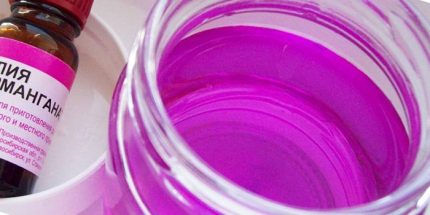
If necessary, you can combine several different solutions, or rinse with different means alternately.
For example, it is better to be the first to use vinegar-manganese solution in water, then rinse the gas cylinder with a solution based on dishwashing detergent. The latter will help neutralize the smell of vinegar, and leave behind a pleasant aroma of purity.
Safety instructions for cleaning the cylinder
Even if the old gas cylinder has not been used for its intended purpose for a long time, the fact of the presence of propane inside the tank cannot be ruled out. If you immediately start cutting the receiver without first rinsing it, things may end big bangthat will provoke even the slightest spark.
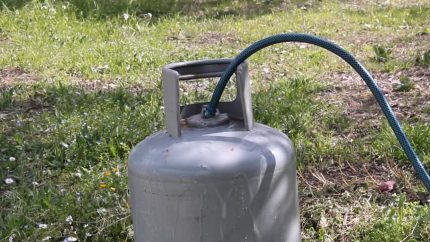
Due to the tightness of the propane receiver, the remaining gas will still remain inside the cylinder until the valve is safely removed.
Therefore, when preparing a cylinder for sawing, it is important to adhere to the following rules:
- try to unscrew the valve on your own, especially if it is fully operational without resorting to sawing the structure;
- even after successfully unwinding the valve, it is important not to roll, and not to drop the gas cylinder;
- it is not recommended to flush the container near the fire source, since even in combination with water the gas can ignite;
- it is advisable to rinse the balloon away from the premises, because the pungent odor of the odorant can “settle” in your home for a long time;
- valve cut with grinders contraindicated due to the likelihood of fire or explosion.
If a gas cylinder has stood for a long time with an open valve, this does not mean that it does not need to be cleaned.
On the inner walls of the tank there are still gas residues that must be flushed with at least plain water.

In the process of unscrewing the valve, it is recommended to use a professional gas wrench, however, in the absence of such, you can build the tool yourself.
If the valve cannot be unscrewed with a simple wrench, you can resort to cutting the valve with a hacksaw.
Conclusions and useful video on the topic
Detailed instructions for flushing and subsequent steaming the gas receiver are presented in this video:
The article presented the best ways to flush a gas cylinder, allowing you to quickly and safely remove residual propane from the tank. The rules for preparing the receiver for washing will help make the process safer, and in this case, a certain sequence of actions must be observed.
When cleaning the container, it is important to use additives without an alcohol base in order to avoid life-threatening consequences.
Have you already washed the gas bottle before sawing it? If you know more effective ways to clean the propane receiver, then you simply must share your experience with our readers. Tell us your story of flushing a gas cylinder, and tell us about the tools that you used as a neutralizer for the smell of propane.

 Why is a gas cylinder covered with hoarfrost: causes of freezing of gas in the cylinder and ways to prevent it
Why is a gas cylinder covered with hoarfrost: causes of freezing of gas in the cylinder and ways to prevent it 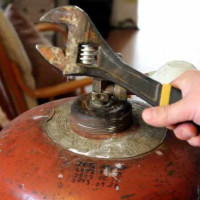 How to disassemble a gas cylinder: step by step instructions + precautions
How to disassemble a gas cylinder: step by step instructions + precautions 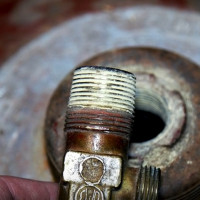 How to unscrew a valve on a gas cylinder: safe ways to disconnect a valve
How to unscrew a valve on a gas cylinder: safe ways to disconnect a valve 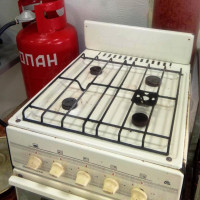 How to connect a gas cylinder to a gas stove: standards and connection guide
How to connect a gas cylinder to a gas stove: standards and connection guide  What to do if the gas fireplace does not turn on: possible causes and solutions to the problem
What to do if the gas fireplace does not turn on: possible causes and solutions to the problem 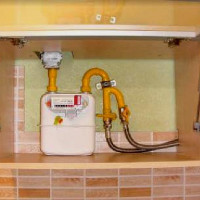 How to hide a gas meter in the kitchen: norms and requirements + popular methods of disguise
How to hide a gas meter in the kitchen: norms and requirements + popular methods of disguise  How much does it cost to connect gas to a private house: the price of organizing gas supply
How much does it cost to connect gas to a private house: the price of organizing gas supply  The best washing machines with dryer: model rating and customer tips
The best washing machines with dryer: model rating and customer tips  What is the color temperature of light and the nuances of choosing the temperature of the lamps to suit your needs
What is the color temperature of light and the nuances of choosing the temperature of the lamps to suit your needs  Replacement of a geyser in an apartment: replacement paperwork + basic norms and requirements
Replacement of a geyser in an apartment: replacement paperwork + basic norms and requirements